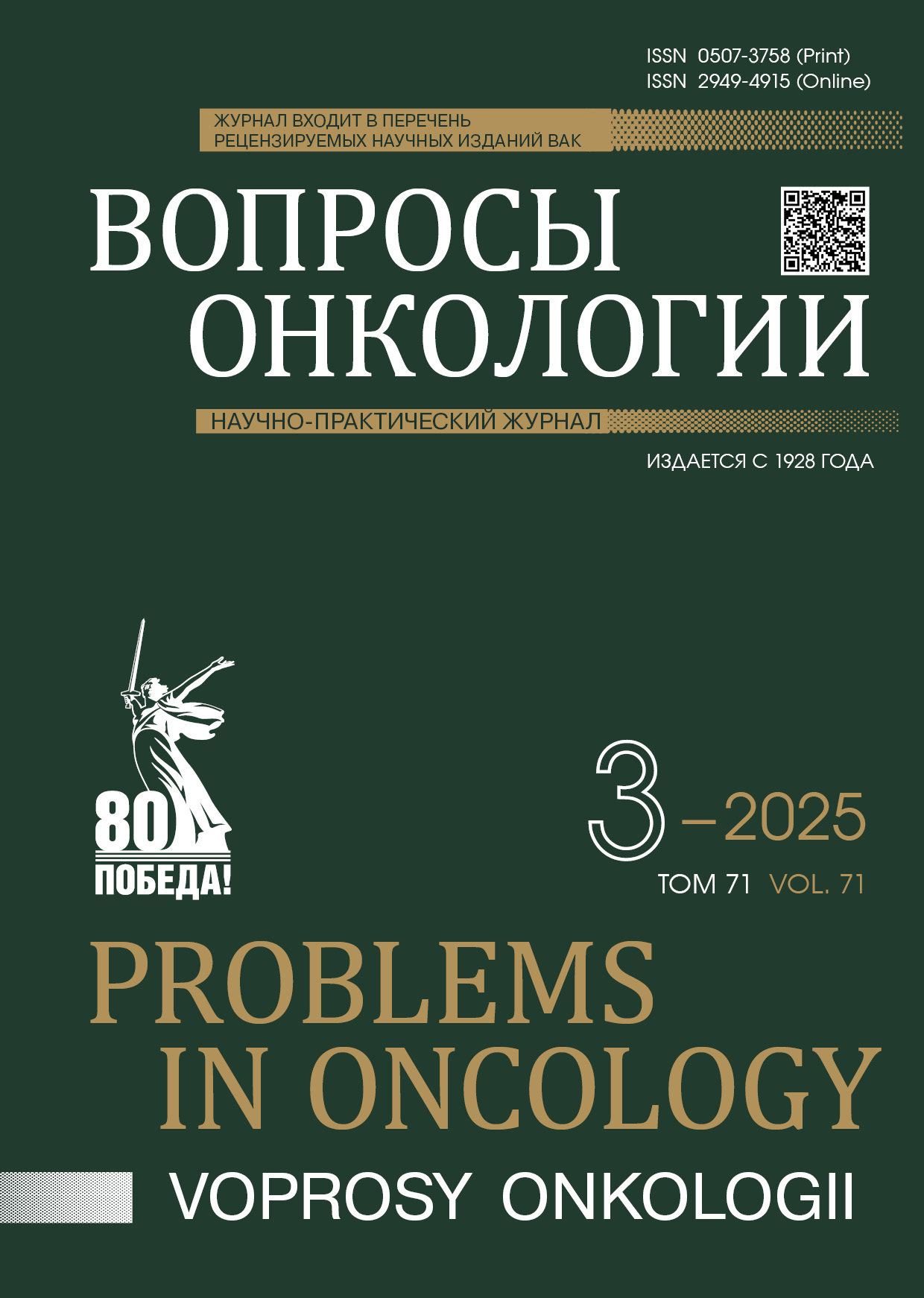Аннотация
Введение. Самым агрессивным и сложным для терапии подтипом РМЖ является тройной негативный рак молочной железы (ТНРМЖ), что подчеркивает необходимость поиска и разработки новых лекарственных препаратов. Для тестирования эффективности препаратов в качестве модельных систем все чаще используют модели ксенотрансплантатов, полученных от пациентов (PDX модели), так как они лучше воспроизводят характеристики человеческих опухолей и их ответ на действие терапии, чем другие типы моделей.
Цель. Создать PDX модель ТНРМЖ и охарактеризовать ее чувствительность к некоторым химиотерапевтическим препаратам для лечения ТНРМЖ, а именно доцетакселу, паклитакселу и цисплатину.
Материалы и методы. Образцы ТНРМЖ были получены от 10 пациенток и имплантированы подкожно иммунодефицитным мышам. Для гистологического исследования выполняли окрашивание гематоксилином и эозином, для иммуногистохимического исследования выполняли окрашивание с использованием антител к рецептору эстрадиола, рецептору прогестерона, рецептору человеческого эпидермального фактора роста 2 типа. Анализ чувствительности PDX модели ТНРМЖ к препаратам выполняли на 3-ей генерации PDX: группе 1 вводили паклитаксел (5 мг/кг), группе 2 — доцетаксел (1 мг/кг), группе 3 — цисплатин (5 мг/кг), группе 4 (контроль) — физиологический раствор (n = 7 для каждой группы). Замеры опухолевых узлов осуществляли дважды в неделю. Полученные данные анализировали при помощи программы STATISTICA 10.0, данные представлены в виде среднего ± ошибка среднего.
Результаты. В 3 случаях из 10 (30 %) произошло приживление опухолевого материала у иммунодефицитных мышей, однако только одна модель PDX продемонстрировала устойчивый рост в результате последовательных ксенотрансплантаций. Установлено, что полученная модель PDX воспроизводит гистотип и характер экспрессии рецепторов эстрогена, прогестерона и рецептора HER2 донорской опухоли. При воздействии доцетакселом, паклитакселом и цисплатином объемы опухолевых узлов составили 290,1 ± 22,3 мм3 (p < 0,05), 314,3 ± 20,0 мм3 и 212,3 ± 19,2 мм3 соответственно, что было значимо меньше, чем в контроле, который составил 478,1 ± 50,2 мм3.
Выводы. Полученная PDX модель соответствует подтипу ТНРМЖ и характеризуется чувствительностью к доцетакселу, паклитакселу и цисплатину. Данную PDX модель можно рассматривать в качестве ценного инструмента для исследований эффективности новых терапевтических стратегий против ТНРМЖ.
Библиографические ссылки
Matossian M.D., Giardina A.A., Wright M.K., et al. Patient-derived xenografts as an innovative surrogate tumor model for the investigation of health disparities in triple negative breast cancer. Women's Health Reports. 2020; 1(1): 383-392. URL: https://www.sci-hub.ru/10.1089/whr.2020.0037.
Derakhshan F., Reis-Filho J.S. Pathogenesis of triple-negative breast cancer. Annual Review of Pathology: Mechanisms of Disease. 2022; 17(1): 181-204.-DOI: 10.1146/annurev-pathol-042420-093238.
Cortes J., Rugo H.S., Cescon D.W., et al. Pembrolizumab plus chemotherapy in advanced triple-negative breast cancer. New England Journal of Medicine. 2022; 387(3): 217-226.-DOI: 10.1056/NEJMoa2202809.
Powell R.T., Rinkenbaugh A.L., Guo L., et al. Targeting neddylation and sumoylation in chemoresistant triple negative breast cancer. NPJ Breast Cancer. 2024; 10(1): 37.-DOI: 10.1038/s41523-024-00644-4.
Lee M.W., Miljanic M., Triplett T., et al. Current methods in translational cancer research. Cancer and Metastasis Reviews. 2021; 40: 7-30.-DOI: 10.1007/s10555-020-09931-5
Zeng M., Ruan Z., Tang J., et al. Generation, evolution, interfering factors, applications, and challenges of patient-derived xenograft models in immunodeficient mice. Cancer Cell International. 2023; 23(1): 120.-DOI: 10.1186/s12935-023-02953-3.
Roy S., Whitehead T.D., Li S. et al. Co-clinical FDG-PET radiomic signature in predicting response to neoadjuvant chemotherapy in triple-negative breast cancer. European journal of nuclear medicine and molecular imaging. 2022; 49(2): 550-562.-DOI: 10.1007/s00259-021-05489-8.
Vaklavas C., Matsen C.B., Chu Z. et al. TOWARDS study: Patient-derived xenograft engraftment predicts poor survival in patients with newly diagnosed triple-negative breast cancer. JCO Precision Oncology. 2024; 8: e2300724.-DOI: 10.1200/PO.23.00724.
Matossian M.D., Burks H.E., Bowles A.C., et al. A novel patient-derived xenograft model for claudin-low triple-negative breast cancer. Breast Cancer Res Treat. 2018; 169(2): 381-390.-DOI: 10.1007/s10549-018-4685-2.
Ляшенко И.С., Романова М.В., Гончарова А.С., et al. Сравнительная характеристика ортотопической и гетеротопической моделей in vivo рака молочной железы человека. Южно-Российский онкологический журнал. 2024; 5(1): 25-33.-DOI: 10.37748/2686-9039-2024-5-1-3. [Lyashenko I.S., Romanova M.V., Goncharova A.S., et al. Evaluation of engraftment and growth dynamics of orthotopic and heterotopic in vivo models of human breast cancer. South Russian Journal of Cancer = Yuzhno-Rossijskij onkologicheskij zhurnal. 2024; 5(1): 25-33.-DOI: 10.37748/2686-9039-2024-5-1-3 (in Rus)].
Na D., Moon H.G. Patient-derived xenograft models in breast cancer research. Translational Research in Breast Cancer. 2021; 1187: 283-301. -DOI: 10.1007/978-981-32-9620-6_14.
Кит О.И., Ващенко Л.Н., Дашкова И.Р., et al. Ксеногенные модели рака молочной железы человека в экспериментальных исследованиях. Современные проблемы науки и образования. 2019; 6: 184-184. [Kit O.I., Vaschenko L.N., Dashkova I.R., et al. Xenogenic models of human breast cancer in experimental studies. Modern Problems of Science and Education = Sovremennye Problemy Nauki i Obrazovaniya. 2019; 6: 184-184. (in Rus)]. URL: https://science-education.ru/ru/article/view?id=29229.
Idrisova K.F., Simon H.U., Gomzikova M.O. Role of patient-derived models of cancer in translational oncology. Cancers. 2022; 15(1): 139. -DOI: 10.3390/cancers15010139.
Katsiampoura A., Raghav K., Jiang Z.Q., et al. Modeling of patient-derived xenografts in colorectal cancer. Molecular cancer therapeutics. 2017; 16(7): 1435-1442. -DOI: 10.1158/1535-7163.MCT-16-0721.
Hernandez M.C., Bergquist J.R., Leiting J.L., et al. Patient-derived xenografts can be reliably generated from patient clinical biopsy specimens. Journal of Gastrointestinal Surgery. 2019; 23: 818-824.-DOI: 10.1007/s11605-019-04109-z.
Guillen K.P., Fujita M., Butterfield A.J., et al. A human breast cancer-derived xenograft and organoid platform for drug discovery and precision oncology. Nature Cancer. 2022; 3(2): 232-250. -DOI: 10.1038/s43018-022-00337-6.

Это произведение доступно по лицензии Creative Commons «Attribution-NonCommercial-NoDerivatives» («Атрибуция — Некоммерческое использование — Без производных произведений») 4.0 Всемирная.
© АННМО «Вопросы онкологии», Copyright (c) 2025

